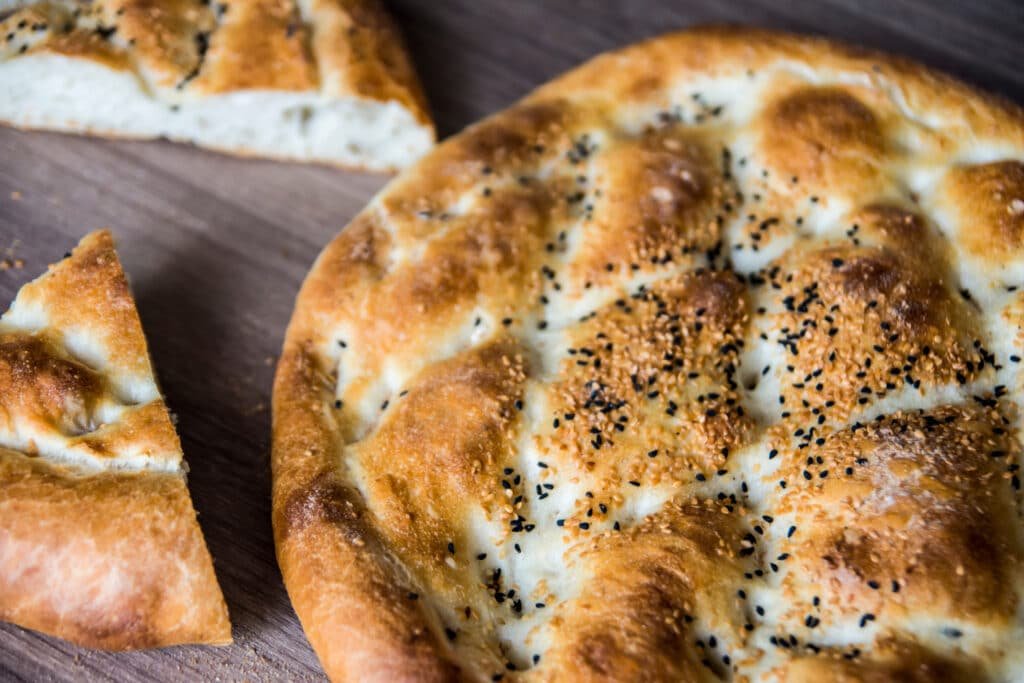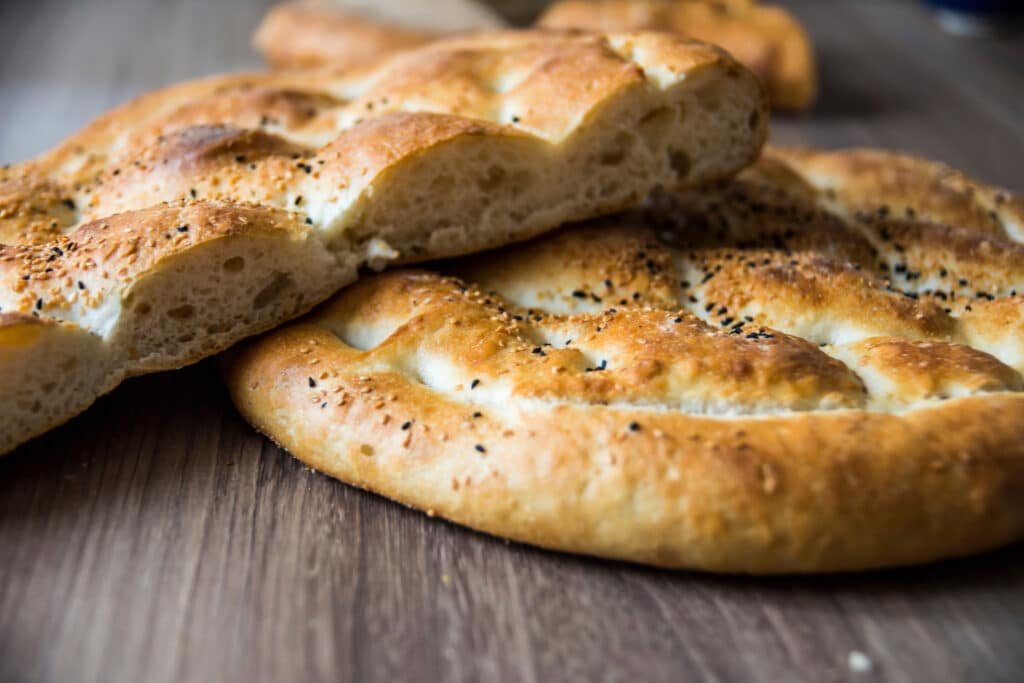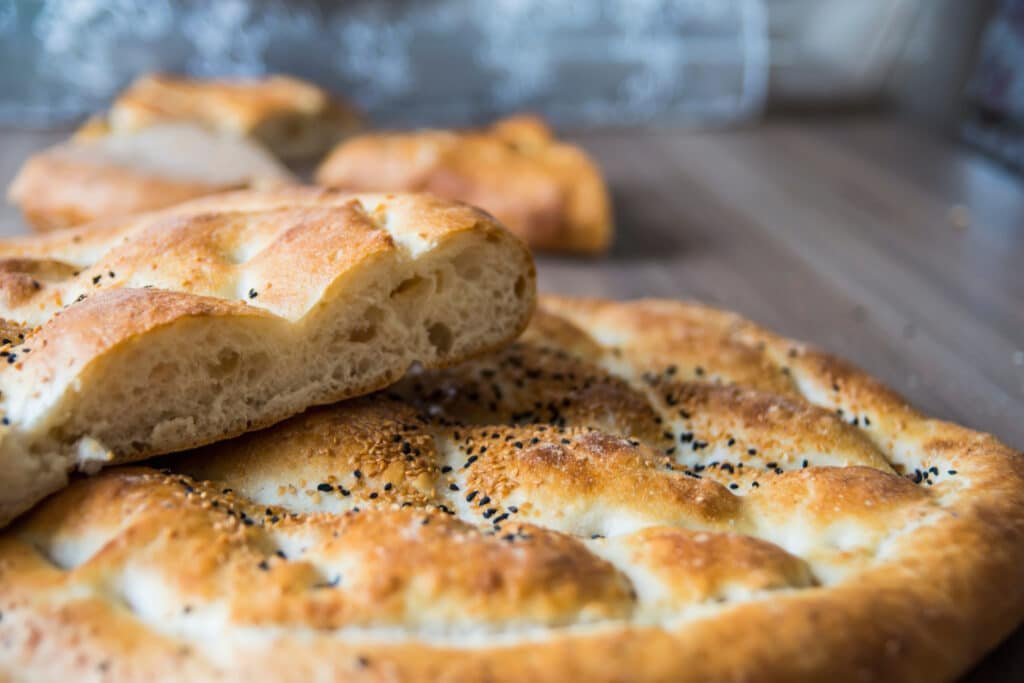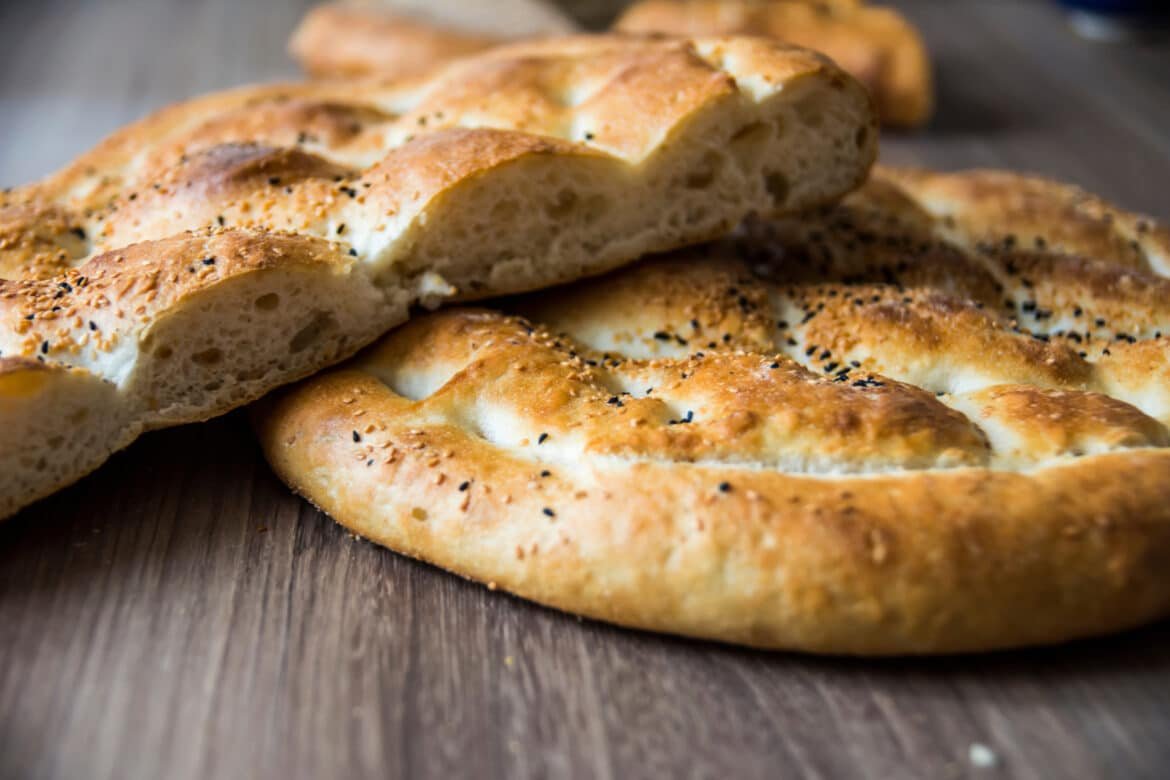Experience the soft and airy texture of Turkish Bread. Perfect for dipping in olive oil or topping with your favorite fillings, this round, thin loaf is made with a simple mixture of flour, yeast, water, and salt. Try it straight out of the oven for the ultimate taste experience.
Turkish bread is a type of bread that originated in Turkey and is widely popular in the Mediterranean region. It is a staple food in Turkish cuisine and is known for its unique texture, flavor, and versatility. Turkish bread is typically round or oval-shaped with a soft, chewy texture and a slightly crisp crust. It is often baked in a stone oven and has a distinctive, slightly charred flavor.
The ingredients used to make Turkish bread typically include flour, yeast, water, salt, and sometimes sugar. Some variations may also include ingredients such as whole wheat flour, sesame seeds, or poppy seeds. Turkish bread can be enjoyed on its own as a snack, used to make sandwiches, or served as a side dish. It is also a popular choice for dips, such as hummus, or for wrapping kebabs.

What makes Turkish bread different?
Turkish bread, also known as pide bread, is a traditional bread from Turkey that is characterized by its oval or boat shape, chewy texture, and slightly crisp exterior. Some of the unique features of Turkish bread include:
- Shape: Turkish bread is typically shaped into an oval or boat shape, which makes it easier to fill with various ingredients for sandwiches or other dishes.
- Texture: Turkish bread has a slightly chewy texture, which is due to the use of high-protein flour, a longer fermentation process, and the use of a relatively wet dough.
- Crust: The crust of Turkish bread is typically crispy, which is achieved by baking the bread in a very hot oven, sometimes with a steam bath.
- Flavor: Turkish bread has a mild, slightly tangy flavor due to the use of yeast and sometimes other ingredients, such as olive oil or sesame seeds, in the dough.
Overall, Turkish bread is a versatile bread that is well-suited for a variety of dishes, from sandwiches to dips and more. Its unique texture and flavor make it a popular choice in Turkish cuisine and around the world.
What is Turkish bread made of?
Turkish bread is typically made with a combination of flour, water, yeast, salt, and sometimes other ingredients such as olive oil or sesame seeds. The specific ingredients and ratios may vary depending on the recipe, but the basic ingredients for Turkish bread are:
- Flour: High-protein flour, such as all-purpose or bread flour, is typically used to make Turkish bread.
- Water: Water is used to hydrate the flour and other ingredients in the dough.
- Yeast: Yeast is used to help the dough rise and provide a slightly tangy flavor.
- Salt: Salt is used to enhance the flavor of the bread and regulate yeast activity.
Other ingredients, such as olive oil or sesame seeds, may be added to the dough to enhance the flavor and texture of the bread. Some recipes may also call for sugar or other sweeteners, which can affect the flavor and texture of the bread. The ingredients are combined and mixed to form a dough, which is then shaped, proofed, and baked to make Turkish bread.

What is special about Turkish bread?
- Unique Shape: Turkish bread is shaped into an oval or boat shape, which makes it easily recognizable and perfect for filling with various ingredients.
- Texture: The chewy texture of Turkish bread makes it perfect for dipping into sauces or spreading with spreads and toppings.
- Crispy Crust: The crispy crust of Turkish bread provides a satisfying crunch and contrast to the chewy interior.
- Mild, Slightly Tangy Flavor: Turkish bread has a mild, slightly tangy flavor that is well-suited for a variety of dishes, from sandwiches to dips and more.
- Versatility: Turkish bread can be used for a variety of purposes, including sandwiches, dips, and more. Its unique shape, texture, and flavor make it a popular choice in Turkish cuisine and around the world.
What are the little black seeds on Turkish bread?
The little black seeds on Turkish bread are often sesame seeds. Sesame seeds are a common ingredient in many traditional breads, including Turkish bread, and are used for both flavor and texture. The seeds are sprinkled on top of the dough before baking, giving the bread a crunchy texture and nutty flavor.
Sesame seeds are also a source of healthy fats, protein, and minerals, such as magnesium, phosphorus, and iron, which can provide additional nutritional benefits.
Overall, the little black seeds on Turkish bread add to the unique flavor and texture of the bread and make it a popular choice for many people.

Is Turkish bread healthy?
Like all bread, Turkish bread is a source of carbohydrates and can provide energy. However, it can also be high in calories, especially if it is made with added fats, such as oil or butter, or sweeteners.
On the other hand, Turkish bread can also be a good source of fiber and protein, depending on the type of flour used. The use of whole grain flour can increase the fiber content, while the use of high-protein flour can increase the protein content of the bread.
Additionally, Turkish bread can be a source of essential vitamins and minerals, such as thiamin, niacin, and iron, depending on the type of flour used.

Best Turkish Bread Recipe
Servings: 4 Preparation: 15 minutes Cooking time: 20 minutes Calories: 258 Fat: 4.2
Ingredients
- 3 cups all-purpose flour
- 1 tsp active dry yeast
- 1 tsp sugar
- 1 tsp salt
- 1 cup warm water
- 1 tbsp olive oil
- Sesame seeds (for topping)
Instructions
- In a large bowl, mix together the flour, yeast, sugar, and salt.
- Gradually add the warm water and olive oil, stirring until a soft dough forms.
- Turn the dough out onto a floured surface and knead for 10 minutes, or until smooth and elastic.
- Place the dough in a greased bowl, cover with plastic wrap, and let rise in a warm place for 1 hour, or until doubled in size.
- Preheat the oven to 425°F (220°C).
- Grease a baking sheet.
- Divide the dough into 4 equal pieces and shape each piece into a long, thin oval loaf.
- Place the loaves on the prepared baking sheet, brush with water, and sprinkle with sesame seeds.
- Bake for 15-20 minutes, or until the bread is golden brown and sounds hollow when tapped on the bottom.
- Remove the bread from the oven and let it cool completely on a wire rack.
Nutrition:
• Calories: 258
• Fat: 4.2g
• Carbohydrates: 47.8g
• Protein: 8.1g
• Fiber: 1.9g
• Sodium: 299mg
Would you like to join our Pinterest page, where many delicious and simple recipes are shared every day?

Ingredients
- 3 cups all-purpose flour
- 1 tsp active dry yeast
- 1 tsp sugar
- 1 tsp salt
- 1 cup warm water
- 1 tbsp olive oil
- Sesame seeds
Instructions
- In a large bowl, mix together the flour, yeast, sugar, and salt.
- Gradually add the warm water and olive oil, stirring until a soft dough forms.
- Turn the dough out onto a floured surface and knead for 10 minutes, or until smooth and elastic.
- Place the dough in a greased bowl, cover with plastic wrap, and let rise in a warm place for 1 hour, or until doubled in size.
- Preheat the oven to 425°F (220°C).
- Grease a baking sheet.
- Divide the dough into 4 equal pieces and shape each piece into a long, thin oval loaf.
- Place the loaves on the prepared baking sheet, brush with water, and sprinkle with sesame seeds.
- Bake for 15-20 minutes, or until the bread is golden brown and sounds hollow when tapped on the bottom.
- Remove the bread from the oven and let it cool completely on a wire rack.
If you like our recipe, would you please support us by sharing it?
